NEW YORK CITY AFTERMATH: UNION SQUARE
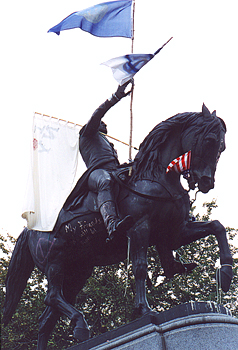
Statue of George Washington Union Square, New York City. September 22, 2001.
In the weeks immediately after the World Trade Center terrorist attacks, 14th Street was the dividing line between the free world and lower Manhattan. Street traffic was stopped by police barricades and pedestrians could enter only by showing proof of residence. Union Square, a large public park extending from 14th to 17th Streets, and an express stop on the Lexington Avenue subway line, became the scene of an all day, all night vigil for families and friends of the missing and the displaced. They were joined by a continuous stream of dumbfounded New Yorkers, trapped tourists, teams of rescuers waiting to serve, and carloads of sympathizers who had driven straight through from everywhere in America, because they could not stay home.
As the weeks passed, mementoes were layered over monuments, creating one of those rare public commemorations where the vernacular and official messages coincide. College students mingled with the elderly and families. Bereaved cousins and co-workers posted snapshots with quirky descriptions. People from Detroit hung a banner made from a bed sheet from a tree. Flowers in vases and jars sat among the planted marigolds. Everyone lit candles, and bent to relight those that had gone out. Babies cried, strangers talked, people read poems or wandered silently, staring at the young, beautiful, smiling photocopied faces of the missing, while drummers beat incessant rhythms.
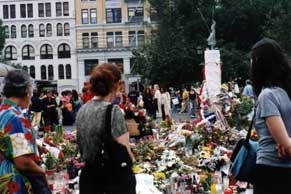
At the center, the equestrian statue of George Washington was festooned with American flags and "I Love New York" banners. Scrawled across the belly of his horse were the words:
My friends
We will survive
Freedom
On the pedestal the word LOVE was written again and again.
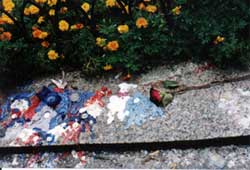
In the end, it rained. The Parks Department removed each piece of paper, each handmade replica of the towers, each teddy bear, and carefully stored it away for future inclusion in some vast, unimaginable official memorial.
Now the Square has returned to normal. The American flag is flying high again. The Peace symbols are nearly washed away. Construction has resumed on the southern periphery, where the park is being extended to create a new pedestrian plaza. It's a neighborhood park and playground again, and larger crowds than usual are turning out to shop at the Saturday Greenmarket.
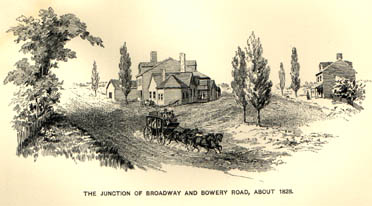
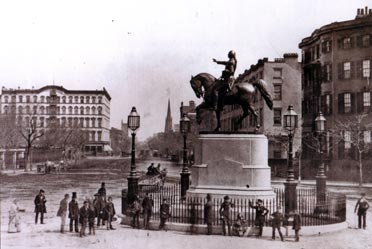
Union Square, ca. 1870. Statue of George Washington by Henry Kirke Brown (after Houdon) on a pedestal by Richard Upjohn.
HISTORICAL NOTES
As Washington Square has been the center of folk art and public performance for Greenwich Village, Union Square has been our speakers' corner. Its history is as variegated as the crowds that gathered there during the weeks after September 11.
The intersection of Broadway and Bowery (the post roads to Albany and Boston respectively) had been named Union Place in 1807 and was still a bucolic crossroad in 1828. The statue of George Washington on horseback, completed in 1856, was the first equestrian statue to be erected in New York after the monument to George III was pulled down (and melted for bullets at the start of the Revolution. It was placed near the spot where General Washington had met the citizens of New York on the day his troops "liberated" the city from the departing British force.
First a potter's field, Union Square became a fashionable residential square as the city's elite moved north. A splendid fountain of the new "Croton water" was installed in 1842. Even after the wealthy moved uptown, Tiffany's and other upscale retail establishments drew them back to the fashionable "Ladies' Mile."
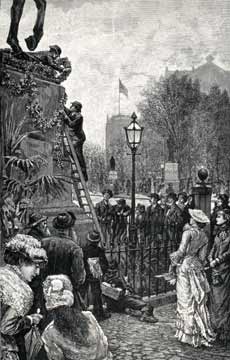
Volunteers decorate George Washington's statue (Harper's Weekly; June 3, 1882)
Later in the century, Union Square lent itself to public commemorations that added double and triple meanings to its name, as first Civil War soldiers and then trade unionists paraded there. It was the scene of the first Labor Day parade in 1882. In 1910, women and girls from the New York Triangle Shirtwaist Factory marched north to Union Square, protesting against their working conditions. The following year, many perished in the fire that swept through their loft building.
During the early 1900's, large department stores like Klein's served workers and their families. But the park itself languished and the neighborhood slowly declined.
Today, after decades of neglect, Union Square is in the midst of a major redesign and renascence. Designated by the National Park Service as a Historic Landmark, it has received $400,000 from the Metropolitan Transit Authority and $2.2 million from the Mayor's capital budget. Construction workers are now creating a half-acre plaza surrounding the Gandhi Gardens at the south end of the park.
Photos on this page © LC Productions, Inc.
